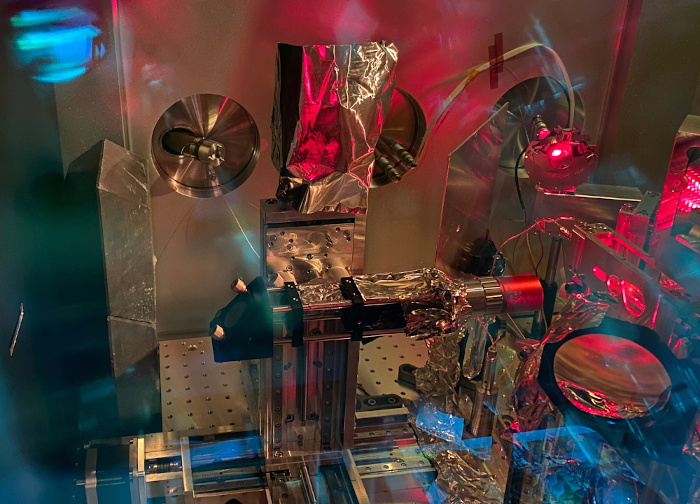Levitating Targets
A multitude of theoretical publications have demonstrated that targets with a limited mass and volume promise a more detailed understanding of the dynamics of the laser-plasma interaction as well as enhanced properties of the resultant particle bunches and radiation. Levitating and thus fully isolated targets in the size-range of the laser focal spot size or even smaller (nano- to micrometer-scale) constitute the ideal case for this scenario.
Although isolated targets are promising in theory, they provide multiple challenges in practise, as already small supporting structures surrounding the target have shown to disturb the interaction significantly.
We have been developing a linear Paultrap that is for the first time capable to access the regime of truly isolated targets experimentally. We levitated single spheres of various materials in the range between 100 nm and 50 µm, covering more than 7 orders of magnitude in terms of particle number and mass. Our systems utilizes a set of sophisticated techniques to load, charge, monitor and position the targets in the focus of a high power laser pulse. Even in ultra high vacuum conditions at background pressures as low as 10⁻⁷ mbar the positioning accuracy is better than 3 micrometer [T.M. Ostermayr et al., Rev. Sci. Instrum. 89, 013302 (2018)].
The Paultrap features a large accessibility for diagnostics, which means it is possible to place ion- or electron diagnostics in almost any direction relative to the high power laser beam.
The setup is designed to be fully transportable and easily adoptable to the specific needs at different laser facilities. This enables us to cover a wide range of target parameters as well as a wide range of laser parameters.
Successful experiments at the Max-Born-Institut in Berlin, the Phelix Laser at GSI Darmstadt [P. Hilz et al., Nat. Comm. 9, 423 (2018)] and the Texas Petawatt Laser at the University of Texas at Austin [T. M. Ostermayr et al., Phys. Rev. E 94, 033208 (2016) ] have been conducted.
Recently the setup has been adopted for increased repetition rate to make better use of the high repetition rate Ti:Sa high power laser systems, such as e.g our own ATLAS 3000 laser at the Centre for Laser Applications (CALA). Pre-plasma studies at the 5TW ZEUS laser have already proven the capability of the target system for these high repetition rate laser systems.
Most recent activities include experiments at the JETI 200 laser at the Helmholtz-Institut in Jena and the ATLAS 3000 laser in Garching.

The following video shows particles that are injected into the trapcenter and get charged. An active damping system extracts energy from the particle until it is at rest.

